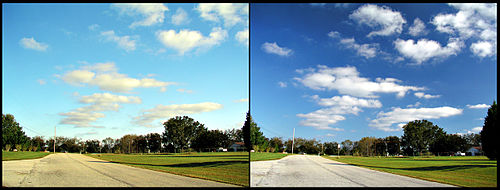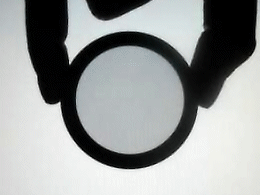31:
134:
199:
148:
291:
284:
267:
260:
120:
106:
233:
175:
166:
224:
Animated polarizer in front of a computer flat screen monitor. LCD monitors emit polarized light, typically at 45° to the vertical, so when the polarizer axis is perpendicular to the polarization of the light from the screen, no light passes through (the polarizer appears black). When parallel to the
371:
Linear polarizing filters can be easily distinguished from circular polarizers. In linear polarizing filters, the polarizing effect works (rotate to see differences) regardless of which side of the filter the scene is viewed from. In "circular" polarizing filters, the polarizing effect works when
311:
rotated to pass only light polarized in the direction perpendicular to the reflected light will absorb much of it. This absorption allows glare reflected from, for example, a body of water or a road to be reduced. Reflections from shiny surfaces (e.g. vegetation, sweaty skin, water surfaces, glass)
238:
234:
380:
Polarizing filters reduce the light passed through to the film or sensor by about one to three stops (2–8×) depending on how much of the light is polarized at the filter angle selected. Auto-exposure cameras will adjust for this by widening the aperture, lengthening the time the shutter is open,
334:
Polarizing filters can be rotated to maximize or minimize admission of polarized light. They are mounted in a rotating collar for this purpose; one need not screw or unscrew the filter to adjust the effect. Rotating the polarizing filter will make rainbows, reflections, and other polarized light
323:
Use of a polarizing filter, in the correct direction, will filter out the polarized component of skylight, darkening the sky; the landscape below it, and clouds, will be less affected, giving a photograph with a darker and more dramatic sky, and emphasizing the clouds. Perpendicularly incident
338:
The benefits of polarizing filters are the same in digital or film photography. While software post-processing can simulate many other types of filter, a photograph does not record the light polarization, so the effects of controlling polarization at the time of exposure cannot be replicated in
319:
Some of the light coming from the sky is polarized (bees use this phenomenon for navigation). The electrons in the air molecules cause a scattering of sunlight in all directions. This explains why the sky is not dark during the day. But when looked at from the sides, the light emitted from a
235:
324:
light waves tend to reduce clarity and saturation of certain colors, which increases haziness. The polarizing lens effectively absorbs these light waves, rendering outdoor scenes crisper with deeper color tones in subject matter such as blue skies, bodies of water and foliage.
239:
367:
on the back. The quarter-wave plate converts the selected polarization to circularly polarized light inside the camera. This works with all types of cameras, because mirrors and beam-splitters split circularly polarized light the same way they split unpolarized light.
237:
312:
are also reduced. This allows the natural color and detail of what is beneath to come through. Reflections from a window into a dark interior can be much reduced, allowing it to be seen through. (The same effects are available for vision by using polarizing
320:
specific electron is totally polarized. Hence, a picture taken in a direction at 90 degrees from the sun can take advantage of this polarization. Actually, the effect is visible in a band of 15° to 30° measured from the optimal direction.
347:
There are two types of polarizing filters readily available, linear and circular, which have exactly the same effect photographically. But the metering and auto-focus sensors in certain cameras, including virtually all auto-focus
236:
219:
331:(calcite) or water droplets producing rainbows. The polarization of the rainbow is caused by the internal reflection. The rays strike the back surface of the drop close to the Brewster angle.
73:, a linear polarizer can be used to change the balance of the light in the photograph. The rotational orientation of the filter is adjusted for the preferred artistic effect.
381:
and/or increasing the ASA/ISO speed of the camera. Polarizing filters can be used deliberately to reduce available light and allow use of wider apertures to shorten
421:
111:
Filtered on right, ⇢. A polarizer filters out the polarized component of light from the sky in a color photograph, increasing contrast with the clouds (right).
30:
50:
557:
392:
by having two linear polarizing layers. When they are at 90° to each other, they let almost zero light in, admitting more as the angle decreases.
356:
used to split off the light for focusing and metering are polarization-dependent. Linearly-polarized light may also defeat the action of the
84:, which further transforms the linearly polarized light into circularly-polarized light. The circular polarization avoids problems with
471:
153:
Filtered on right, ⇢. Effect of polarizer on light reflected from a water surface. The polarizing filter is used on the right.
537:
125:
Filtered on right, ⇢. Polarizer aligned to allow the light reflected by the water (left), rotated by 90° to block it (right).
372:
the scene is viewed from the male threaded (back) side of the filter, but does not work when looking through it backwards.
80:(CPL) is typically used, which has a linear polarizer that performs the artistic function just described, followed by a
17:
357:
594:
335:
stand out or nearly disappear depending on how much of the light is polarized and the angle of polarization.
565:
349:
69:
from the surface of lakes or the sea. Since reflections (and sky-light) tend to be at least partially
486:
589:
92:
sensors in some cameras, which otherwise may not function reliably with only a linear polarizer.
225:
screen polarization, the polarizer allows the light to pass and the white of the screen is seen.
389:
523:
363:
Circular polarizing photographic filters consist of a linear polarizer on the front, with a
401:
300:
62:
8:
435:
328:
304:
34:
139:
Filtered on right, ⇢. Polarizers are often used to improve the appearance of vegetation.
364:
327:
Much light is differentiated by polarization, e.g. light passing through crystals like
209:
81:
77:
70:
472:"DSLR Tips Workshop: How to use polarizing filters to reduce haze and deepen blue sky"
37:/linear analyzer filtering unpolarized light and then circularly polarizing the result
533:
440:
508:
205:
212:
are clearly seen when photographed through a polarizing filter (bottom picture).
529:
382:
89:
66:
583:
444:
353:
133:
218:
184:
58:
54:
290:
283:
266:
198:
147:
313:
259:
308:
119:
85:
105:
352:(SLRs), will not work properly with linear polarizers because the
433:
Wehner, R. (July 1976). "Polarized-light navigation by insects".
174:
187:
photographed without (left) and with a polarizing filter (right)
484:
165:
420:
Handbook of Optics Second edition vol2, Ch22.19, Bass M
299:
Light reflected from a non-metallic surface becomes
307:, about 56° from the vertical for common glass. A
53:) is a filter that is often placed in front of a
581:
521:
439:. Vol. 235, no. 1. pp. 106–15.
422:An extensive quote has been copied and pasted
558:"Polarizer: Another must have filter !"
525:Camera Technology: The Dark Side of the Lens
562:All Day I Dream About Photography (ADIDAP)
289:
282:
265:
258:
457:Halliday, David, Resnick, Robert (1966).
360:(low-pass filter) on the imaging sensor.
231:
208:of car rear window. Variations in glass
29:
14:
582:
432:
485:Emma David for FreePhotoCourse.com.
487:"How to Photography: Dark Blue Sky"
243:Video of the effects of a polarizer
24:
478:
25:
606:
550:
61:in order to darken skies, manage
461:, p. 1167. John Wiley, New-York.
375:
217:
197:
173:
164:
146:
132:
118:
104:
388:Some companies make adjustable
515:
501:
464:
451:
426:
414:
13:
1:
407:
564:. 2008-03-20. Archived from
303:; this effect is maximum at
7:
395:
385:for certain focus effects.
10:
611:
350:single-lens reflex cameras
509:"Rainbow, halo and glory"
489:. www.FreePhotoCourse.com
522:Norman Goldberg (1992).
342:
183:Filtered on right, ⇢. A
390:neutral density filters
204:Filtered at bottom, ⬇.
27:Lens filter for cameras
244:
95:
76:For modern cameras, a
38:
242:
33:
595:Polarization (waves)
532:. pp. 141–147.
402:Polarized 3D glasses
358:anti-aliasing filter
277:90 degrees rotation
274:60 degrees rotation
253:30 degrees rotation
51:spelling differences
436:Scientific American
250:0 degrees rotation
365:quarter-wave plate
245:
82:quarter-wave plate
78:circular polarizer
71:linearly-polarized
39:
35:Circular polarizer
539:978-0-12-287570-0
297:
296:
240:
47:polarising filter
43:polarizing filter
18:Polarising filter
16:(Redirected from
602:
576:
574:
573:
544:
543:
519:
513:
512:
505:
499:
498:
496:
494:
482:
476:
475:
468:
462:
455:
449:
448:
430:
424:
418:
305:Brewster's angle
293:
286:
269:
262:
247:
246:
241:
221:
201:
177:
168:
150:
136:
122:
108:
21:
610:
609:
605:
604:
603:
601:
600:
599:
590:Optical filters
580:
579:
571:
569:
556:
553:
548:
547:
540:
520:
516:
507:
506:
502:
492:
490:
483:
479:
470:
469:
465:
456:
452:
431:
427:
419:
415:
410:
398:
378:
345:
232:
230:
229:
228:
227:
226:
222:
214:
213:
206:Toughened glass
202:
191:
190:
189:
188:
180:
179:
178:
170:
169:
158:
157:
156:
155:
154:
151:
142:
141:
140:
137:
128:
127:
126:
123:
114:
113:
112:
109:
98:
28:
23:
22:
15:
12:
11:
5:
608:
598:
597:
592:
578:
577:
552:
551:External links
549:
546:
545:
538:
530:Academic Press
514:
500:
477:
463:
450:
425:
412:
411:
409:
406:
405:
404:
397:
394:
383:depth of field
377:
374:
354:beam splitters
344:
341:
295:
294:
287:
279:
278:
275:
271:
270:
263:
255:
254:
251:
223:
216:
215:
203:
196:
195:
194:
193:
192:
182:
181:
172:
171:
163:
162:
161:
160:
159:
152:
145:
144:
143:
138:
131:
130:
129:
124:
117:
116:
115:
110:
103:
102:
101:
100:
99:
97:
94:
90:light-metering
65:, or suppress
26:
9:
6:
4:
3:
2:
607:
596:
593:
591:
588:
587:
585:
568:on 2021-05-27
567:
563:
559:
555:
554:
541:
535:
531:
527:
526:
518:
510:
504:
488:
481:
473:
467:
460:
454:
446:
442:
438:
437:
429:
423:
417:
413:
403:
400:
399:
393:
391:
386:
384:
376:Other effects
373:
369:
366:
361:
359:
355:
351:
340:
336:
332:
330:
325:
321:
317:
315:
310:
306:
302:
292:
288:
285:
281:
280:
276:
273:
272:
268:
264:
261:
257:
256:
252:
249:
248:
220:
211:
207:
200:
186:
176:
167:
149:
135:
121:
107:
93:
91:
87:
83:
79:
74:
72:
68:
64:
60:
56:
52:
48:
44:
36:
32:
19:
570:. Retrieved
566:the original
561:
524:
517:
503:
491:. Retrieved
480:
466:
458:
453:
434:
428:
416:
387:
379:
370:
362:
346:
337:
333:
326:
322:
318:
298:
75:
46:
42:
40:
185:glass squid
63:reflections
59:photography
55:camera lens
584:Categories
572:2023-07-23
408:References
339:software.
314:sunglasses
445:0036-8733
329:sunstones
309:polarizer
301:polarized
86:autofocus
396:See also
88:and the
493:June 6,
459:Physics
536:
443:
210:stress
343:Types
67:glare
49:(see
534:ISBN
495:2011
441:ISSN
316:.)
96:Use
57:in
45:or
586::
560:.
528:.
41:A
575:.
542:.
511:.
497:.
474:.
447:.
20:)
Text is available under the Creative Commons Attribution-ShareAlike License. Additional terms may apply.

























